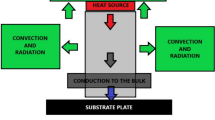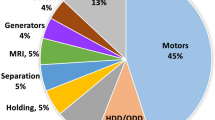Abstract
Over the last 50 years, numerous slab continuous casters have been widely installed all over the world to take advantage of the enhanced productivity, yield, energy efficiency, and cost efficiency. To meet a variety of product quality demands from the steel market, the slab continuous casting process has been diversified into several types. In the 1960s, 200–300 mm thickness slab casters opened the continuous casting era by substituting the ingot process widely applied at that time, and now the major part of slab production is for the hot strip rolling. The thick slab of 400–600 mm thickness casting process with a casting speed range of 0.2–0.6 m/min was introduced to guarantee the internal quality of heavy gauge plates for the energy industry and shipbuilding applications. For the ultra-thick, over 600 mm, the semi-continuous casting technology with a casting speed of 0.05–0.2 m/min has been developed as an alternative way to replace the ingot process, with higher yield and productivity compared to the case of the ingot process.
As a supplementary concept, the near-net-shape casting with 50–100 mm slab thickness was developed to minimize energy consumption, and consequently thin slab casting and rolling process (TSCR) was commercially adopted, with the development of high speed casting technology. Recently, the thin slab casting and rolling (TSCR) process was progressed further as an endless rolling process with a casting speed up to 8 m/min for ultra-thin high-strength strip production. As another extreme case, the strip casting process was developed to directly produce thin strips of less than 5 mm from molten steel at the highest casting speed of 30–100 m/min, which has been focused on producing the specific steel grade using its ultra-fast solidification features. This article discusses why the range of casting speed has been spread out as caster types. The continuous casting processes are briefly introduced, and the related key technologies and products are reviewed in the casting speed point of view, based on POSCO’s experience.
Zusammenfassung
In den letzten 50 Jahren hat sich das Brammenstranggießen aus Gründen der höheren Produktivität, des verbesserten Ausbringens und der Energie- und Kosteneffizienz zum Standardgießverfahren für die Herstellung von Flachprodukten entwickelt. Seit den 1960ern werden 200 bis 300 mm dicke Brammen als Vormaterial für Warmbreitbandstraßen produziert. Das Vergießen von 400 bis 600 mm dicken Brammen mit Gießgeschwindigkeiten von 0.2–0.6 m/min wurde entwickelt, um die Innenqualität von Grobblech für den Energiesektor und die Schiffbauindustrie sicherzustellen. Für ultra-dicke Brammen mit Dicken von mehr als 600 mm wird das semi-kontinuierliche Gießen mit Geschwindigkeiten von 0.05–0.2 m/min den Blockgießprozess auf Grund von höherer Produktivität und höheren Ausbringens ersetzen.
Ergänzend wurde das endabmessungsnahe Vergießen von Brammen mit Dicken von 500 bis 100 mm bei hohen Gießgeschwindigkeiten entwickelt, um im Gießwalzverbund energiesparend Warmband herzustellen. Nunmehr wurde der Gießwalzverbund zum Endlosgießwalzen mit Gießgeschwindigkeiten von bis zu 8 m/min für die Produktion von besonders dünnem, hochfestem Band weiterentwickelt.
Als weiteres Extrem wurde der Bandgießprozess zur direkten Produktion von Dünnband mit Dicken von weniger als 5 mm bei Gießgeschwindigkeiten von 30 bis 100 m/min entwickelt, wobei die schnelle Erstarrung für bestimmte Stahlsorten sehr vorteilhaft ist.
Der vorliegende Beitrag betrachtet die unterschiedlichen Prozesse, die entsprechenden Schlüsseltechnologien und Gießgeschwindigkeiten in Hinblick auf die hergestellten Produkte aus Sicht von POSCO, dem weltweit einzigen Betreiber und Entwickler aller genannten Prozesse.













Similar content being viewed by others
References
Okumura, H.: Recent trends and future prospects of continuous casting technology, Nippon Steel Technical Report, 1994, 61 (1994), p 9
Okayama, Y.; Kawazoe, F.; Yasui, H.; Umeki, S.; Hara, K.; Kato, H.; Ueshima , Y.; Hoshino, M.: Production of High Quality Extra Heavy Plates with New Casting Equipment, Nippon Steel Technical Report, 99 (2004), p 59
Harste, K.; Klingbell, J.; Schwinn, V.; Bannenberg, N.; Bergmann, B.: Die neue Stranggiessanlage der Dillinger Hütte als Vorstrufe zur Erzeugung von Grobblechen mit höchsten Qualtätsanforderungen, Stahl und Eisen, 120 (2000), no 2, p 53
Oh, K. S.; Lee, J. D.; Kim S. J.; Choi, J. Y.: Development of a large ingot continuous caster, Metall. Res. Technol., 112 (2015), no 2, p 203
Author information
Authors and Affiliations
Corresponding author
Rights and permissions
About this article
Cite this article
Lee, S. State of the Art Technology in Slab Continuous Casting:. Berg Huettenmaenn Monatsh 163, 3–10 (2018). https://doi.org/10.1007/s00501-017-0695-3
Received:
Accepted:
Published:
Issue Date:
DOI: https://doi.org/10.1007/s00501-017-0695-3
Keywords
- Continuous casting
- Thick slab casting
- Semi-continuous casting
- High speed casting
- Thin slab casting
- Strip casting
- CEM®
- PoStrip®
- LICC




